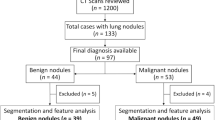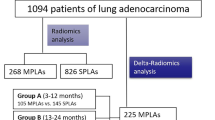Abstract
Purpose
Spread through air space (STAS) is a novel invasive pattern of lung adenocarcinoma and is also a risk factor for recurrence and worse prognosis of lung adenocarcinoma. The aims of this study are to develop and validate a computed tomography (CT)‑based radiomics model for preoperative prediction of STAS in lung adenocarcinoma.
Methods and materials
This retrospective study was approved by an institutional review board and included 462 (mean age, 58.06 years) patients with pathologically confirmed lung adenocarcinoma. STAS was identified in 90 patients (19.5%). Two experienced radiologists segmented and extracted radiomics features on preoperative thin-slice CT images with radiomics extension independently. Intraclass correlation coefficients (ICC) and Pearson’s correlation were used to rule out those low reliable (ICC < 0.75) and redundant (r > 0.9) features. Univariate logistic regression was applied to select radiomics features which were associated with STAS. A radiomics-based machine learning predictive model using a random forest (RF) was developed and calibrated with fivefold cross-validation. The diagnostic performance of the model was measured by the area under the curve (AUC) of receiver operating characteristic (ROC).
Results
With univariate analysis, 12 radiomics features and age were found to be associated with STAS significantly. The RF model achieved an AUC of 0.754 (a sensitivity of 0.880 and a specificity of 0.588) for predicting STAS.
Conclusion
CT-based radiomics model can preoperatively predict STAS in lung adenocarcinoma with good diagnosis performance.
Key Points
• CT-based radiomics and machine learning model can predict spread through air space (STAS) in lung adenocarcinoma with high accuracy.
• The random forest (RF) model achieved an AUC of 0.754 (a sensitivity of 0.880 and a specificity of 0.588) for predicting STAS.





Similar content being viewed by others
Abbreviations
- 3D-VOIs:
-
Three-dimensional volumes of interest
- AUC:
-
Area under curve
- CT:
-
Computed tomography
- DICOM:
-
Digital Imaging and Communications in Medicine
- GGN:
-
Ground-glass nodules
- GLCM:
-
Gray level co-occurrence matrix
- GLDM:
-
Gray level dependence matrix
- GLRLM:
-
Gray level run length matrix
- GLSZM:
-
Gray Level size zone matrix
- HGLE:
-
High gray level emphasis
- ICC:
-
Intraclass correlation coefficients
- KV:
-
Kilovolt
- LDCT:
-
Low-dose computed tomography.
- MRI:
-
Magnetic resonance imaging
- NGTDM:
-
Neighboring gray tone difference matrix
- PACS:
-
Picture archiving and communication system
- PC:
-
Personal computer
- RF:
-
Random forest
- ROC:
-
Receiver operating characteristic
- STAS:
-
Spread through air space
References
Siegel RL, Miller KD, Jemal A (2019) Cancer statistics, 2019. CA Cancer J Clin 69:7–34
Amin MB, Tamboli P, Merchant SH et al (2002) Micropapillary component in lung adenocarcinoma: a distinctive histologic feature with possible prognostic significance. Am J Surg Pathol 26:358–364
Blaauwgeers H, Flieder D, Warth A et al (2017) A prospective study of loose tissue fragments in non-small cell lung cancer resection specimens: an alternative view to spread through air spaces. Am J Surg Pathol 41:1226–1230
Travis WD, Brambilla E, Nicholson AG et al (2015) The 2015 World Health Organization classification of lung tumors: impact of genetic, clinical and radiologic advances since the 2004 classification. J Thorac Oncol 10:1243–1260
Kadota K, Nitadori J, Sima CS et al (2015) Tumor spread through air spaces is an important pattern of invasion and impacts the frequency and location of recurrences after limited resection for small stage I lung adenocarcinomas. J Thorac Oncol 10:806–814
Onozato ML, Kovach AE, Yeap BY et al (2013) Tumor islands in resected early-stage lung adenocarcinomas are associated with unique clinicopathologic and molecular characteristics and worse prognosis. Am J Surg Pathol 37:287–294
Shiono S, Yanagawa N (2016) Spread through air spaces is a predictive factor of recurrence and a prognostic factor in stage I lung adenocarcinoma. Interact Cardiovasc Thorac Surg 23:567–572
Dai C, Xie H, Su H et al (2017) Tumor spread through air spaces affects the recurrence and overall survival in patients with lung adenocarcinoma >2 to 3 cm. J Thorac Oncol 12:1052–1060
de Margerie-Mellon C, Onken A, Heidinger BH, VanderLaan PA, Bankier AA (2018) CT manifestations of tumor spread through airspaces in pulmonary adenocarcinomas presenting as subsolid nodules. J Thorac Imaging 33:402–408
Kim SK, Kim TJ, Chung MJ et al (2018) Lung adenocarcinoma: CT features associated with spread through air spaces. Radiology 289:831–840
Kumar V, Gu Y, Basu S et al (2012) Radiomics: the process and the challenges. Magn Reson Imaging 30:1234–1248
Lambin P, Leijenaar RTH, Deist TM et al (2017) Radiomics: the bridge between medical imaging and personalized medicine. Nat Rev Clin Oncol 14:749–762
Bonekamp D, Kohl S, Wiesenfarth M et al (2018) Radiomic machine learning for characterization of prostate lesions with MRI: comparison to ADC values. Radiology 289:128–137
Ueno Y, Forghani B, Forghani R et al (2017) Endometrial carcinoma: MR imaging-based texture model for preoperative risk stratification-a preliminary analysis. Radiology 284:748–757
Mao L, Chen H, Liang M et al (2019) Quantitative radiomic model for predicting malignancy of small solid pulmonary nodules detected by low-dose CT screening. Quant Imaging Med Surg 9:263–272
Mei D, Luo Y, Wang Y, Gong J (2018) CT texture analysis of lung adenocarcinoma: can radiomic features be surrogate biomarkers for EGFR mutation statuses. Cancer Imaging. https://doi.org/10.1186/s40644-018-0184-2
Kuo MD, Jamshidi N (2014) Behind the numbers: decoding molecular phenotypes with radiogenomics--guiding principles and technical considerations. Radiology 270:320–325
Rutman AM, Kuo MD (2009) Radiogenomics: creating a link between molecular diagnostics and diagnostic imaging. Eur J Radiol 70:232–241
Acknowledgments
Thanks to all authors for their contribution to this article.
Funding
The authors state that this work has not received any funding.
Author information
Authors and Affiliations
Corresponding author
Ethics declarations
Guarantor
The scientific guarantor of this publication is Jingshan Gong.
Conflict of interest
The authors of this manuscript declare no relationships with any companies whose products or services may be related to the subject matter of the article.
Statistics and biometry
No complex statistical methods were necessary for this paper.
Informed consent
Written informed consent was waived by the Institutional Review Board.
Ethical approval
Institutional Review Board approval was obtained.
Methodology
• Retrospective
• Observational
• Performed at one institution
Additional information
Publisher’s note
Springer Nature remains neutral with regard to jurisdictional claims in published maps and institutional affiliations.
Rights and permissions
About this article
Cite this article
Jiang, C., Luo, Y., Yuan, J. et al. CT-based radiomics and machine learning to predict spread through air space in lung adenocarcinoma. Eur Radiol 30, 4050–4057 (2020). https://doi.org/10.1007/s00330-020-06694-z
Received:
Revised:
Accepted:
Published:
Issue Date:
DOI: https://doi.org/10.1007/s00330-020-06694-z




